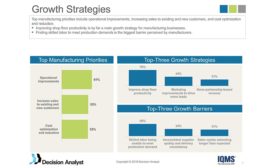Home » software trends
Articles Tagged with ''software trends''
Software & Analysis
Quality professionals need to be concerned with software outside the realm of enterprise quality management systems (EQMS).
Read More
Software & Analysis
The Evolution of Quality Management Systems Software
From the CEO to the Manufacturing Floor, Access to Data Empowers the Organization to Improve.
July 8, 2021
Technology Adoption
The importance of not only how many, but also how quick.
September 1, 2020
Cost of Quality
How a cost of quality approach, already customized for software and information technology, can be applied toward the deployment and implementation of Quality 4.0 in an organization.
September 1, 2020
Adopting a Data-Centered Approach to Compliance via Software Platforms
The future of quality lies in data intelligence, and reliable software platforms can help companies be ready.
March 10, 2020
Defining the Future of ERP in a Quality-Driven World
Manufacturers require ERP systems that can “learn” what excellent quality looks like.
September 1, 2019
From Paper and Pencil to Industry 4.0: Revealing the Value of Data through Quality Intelligence
For manufacturers to realize the full power of quality and the data behind it, they must embrace the technology available.
October 10, 2017
The Benefits of Automating Your Document Control Process
The document control system sets the foundation for an effective quality system.
September 2, 2015
The Journey to Relevance
Six questions for turning the piles of data you’re already collecting into actionable intelligence. The data wave is building.
September 1, 2015
Stay in the know with Quality’s comprehensive coverage of
the manufacturing and metrology industries.
eNewsletter | Website | eMagazine
JOIN TODAY!Copyright ©2024. All Rights Reserved BNP Media.
Design, CMS, Hosting & Web Development :: ePublishing












